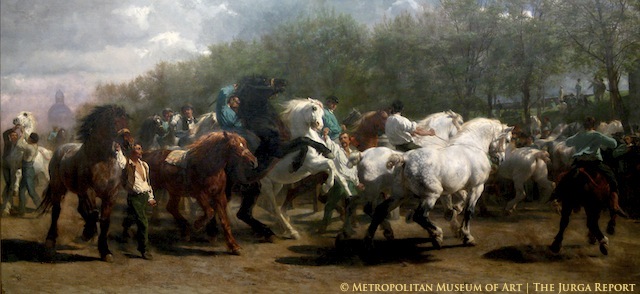What color were ancient horses?
- November 7, 2025
- ⎯ Fran Jurga
[Note: This article was originally published on December 7, 2016.]
Do you have a soft spot for spots? Is your ideal horse a perfect shade of blood bay? Do you live by the old warning, “Chestnut mare? Beware!”?

Horse colors mean a lot, whether we are aware of it or not. We even speak of horses by color, with their coat color morphing from an adjective to a noun: “I think the gray won!” “How did that chestnut do?” “I have my eye on the bay over there.”
The subject is identifiable more by its color than by other distinguishing characteristics like four white stockings, a bobbed tail or even a sway back. Can you think of another animal that is identified by color?
Color matters
Beauty is in the eye of the beholder when it comes to horse color. But there’s nothing new about that. As long as the horse has been domesticated, color has mattered. Human preferences for horse coat colors have changed greatly over time and across cultures, and probably began when uniform-colored wild horses were domesticated. As selective breeding for desirable traits began, coat colors probably changed along with other phenotypic (physical) traits, until unique colors or patterns not typically found in wild horses appeared.
Evidence shows that certain colors have come into fashion periodically and fallen out of favor, as well, over the millennia. The desire for color may have influenced breeding and even the survival or demise of breeds. But how much color meant only became known recently, as high-tech analysis tools in the hands of researchers have enabled the true colors of ancient horses to emerge.
The study
An international research team under the direction of the Leibniz Institute for Zoo and Wildlife Research (IZW) in Berlin, Germany has sorted out the millennia by using horse color.

The ancients loved spots, they tell us. Spotted and “diluted” horses were more populous from the beginning of domestication until the end of the Roman Empire, whereas solid colors (bay, black and chestnut) were dominant in the Middle Ages.
The results of this research have been published in the Open Access journal Scientific Reports.
The study reveals that the diversity of coat colors in horses has been strongly affected by cultural differences since the initial domestication of equids around 3,500 BC. To investigate the history of domestic horses with respect to this charismatic phenotypic character, the scientists analyzed a dataset of 201 samples of ancient horse DNA. In total, they detected 14 different color types.
Early breeds showed six color variants, of which three were already present in pre-domestic horses. During the Bronze Age (2,700 – 900 BC) and Iron Age (900 BC – 400 AD), the number of color variants further increased from six to nine, indicating a human preference for new colors. During these periods spotted and “diluted” horses were most frequent.
Symbolism and weaponry

During medieval times, the attractiveness of spotted horses decreased and solid coat colors, especially chestnut, became dominant. Religious symbolism may have played a role in the shift from dominance to the decline of spotted horses. At the beginning of the Middle Ages this type was preferred by royalty, possibly influenced by the last book of the New Testament, the “Apocalypse of St. John” (AD 81-96). It described four riders on differently-colored horses. The rider of victory was sitting on a white or white spotted horse, whereas the riders of famine (black), death (bay) and war (chestnut) rode on solid colored horses.
After several epidemics, this color symbolism changed: the “good” rider of victory was replaced by the “bad” rider of the plague but still sitting on a white or white-spotted “pale” horse: “And I looked, and behold, a pale horse! And its rider’s name was Death, and Hades followed him!” Consequently, white and spotted horses soon had a negative connotation, resulting in a lower religious prestige for these colors.
Further reasons for the decrease of spotted types might have been novel developments in weaponry such as the longbow, with these horses being an easier target than solid ones.
A good horse …
Until now, little information about the history of horse domestication has been available. “Horses have undergone extensive breeding and breed-specific homogenization, especially during the last few centuries. Therefore, analyzing only modern individuals can lead to false conclusions about the history of the domestic horse,” says Dr Arne Ludwig, scientist at the Leibniz-IZW.
This study is the most comprehensive to date. By addressing historical changes in a physical characteristic in ancient domestic animals, it also provides important implications regarding the origin and development of modern horses. Just like today, specific breeds were preferred by people not only because of their riding performance but also their visual appearance and attractiveness.
Surely, the old saying “A good horse is never a bad color” has been true throughout history, and always will be.
Citation:
Wutke S, Benecke N, Sandoval-Castellanos E, Döhle HJ, Friederich S, Gonzales J, Hallsteinn Hallsson J, Hofreiter M, Lõugas L, Magnell O, Morales-Muniz A, Orlando L, Pálsdóttir AH, Reissmann M, Ruttkay M, Trinks A, Ludwig A (2016): Spotted phenotypes in horses lost attractiveness in the Middle Ages. Scientific Reports. DOI: 10.1038/srep38548
Read the full paper with illustrations on the Nature.com website.
To learn more:
Coat colours and mitochondrial lineages of ancient horses to document domestication is the PhD thesis of Dr. Michael Cieslak, awarded at the University of Free Berlin in 2012. It is posted online with free access through the university.
Thanks to IZW for basic materials used in this article. (Later European paintings selected by author.)





